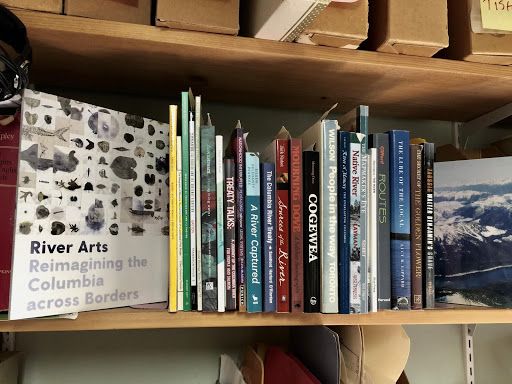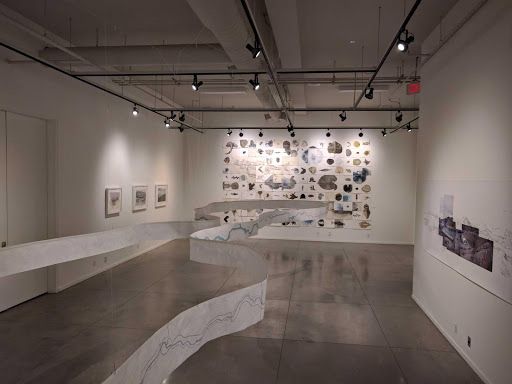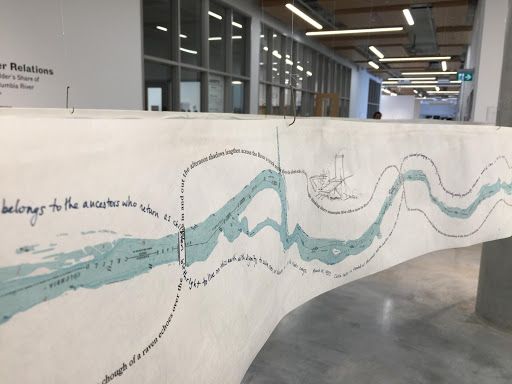Over the past several years I have been working on a project about the Columbia River. The 1964 Columbia River Treaty between the US and Canada came up for possible renegotiation in 2014 and any renegotiations must occur by 2024. From our participation in a “River Relations” artists’ project at Emily Carr University, another west-coast poet Rita Wong and I decided to pursue a collaborative image-text, beholden: a poem as long as the river.
Each of us would write along a shore of the river, from beginning to end, occasionally having our texts cross the river at bridges or dams. Rita’s and my texts were not in conversation as they were written, but, finally, feel tethered to a similar poetic impulse and imagination. One of our group, visual artist Nick Conbere, digitally manipulated maps of the river into a single horizontal panel of 114 feet long. Rita handwrote her text. I composed my text by keyboarding along in Adobe Illustrator. The research and preparation for the project involved travelling along the length of the river, from Canal Flats in the East Kootenay to Fort Astoria on the Oregon coast, as well as intensive reading about the historical, social, political, and ecological aspects of the river, with particular attention to the indigenous concerns and sensibilities that were ignored in the original treaty negotiations.
On a shelf above my desk are some of the books I’ve had on hand during my research and composition. There were many other sources but this shelf is a fair representation of the kind of reading I addressed.

Though I grew up in the West Kootenays, along both the Kootenay and Columbia rivers, and though “the local” is fundamental to my poetics, my 1950’s education was pretty bereft of Canadian, let alone regional, history and affairs. I love the old fur traders’ journals so digging into David Thompson’s was a joy, particularly Jack Nisbet’s books. One of the most cogent texts I was led to was Mourning Dove’s A Salishan Autobiography, early 20th century writings by the first Native American woman to publish a novel (Cogewa) edited by Jay Miller. One of the most challenging concerns has been to locate the Indigenous voices that still echo along the river, especially with the loss of salmon due to dam construction. That cosmology has become more present recently and so it has been revealing to examine, for example, recent writings on indigenous concepts of nationhood and treaty. Co-founder of the “Idle No More” resistance, Sylvia McAdam’s book Nationhood Interrupted: Revitalizing nêhiyaw Legal Systems has been a great help as I’ve tried to rejig the double-sided nature of “treaty” for myself.
A few culturally and socially thoughtful books resonated for me, most especially Lucy Lippard’s The Lure of the Local; her provocations around notions of place and home and her thinking about the ethics of land were useful accompaniments while staring into the river. Michael Taussig’s poetic play on the nostalgia of water in his essay “The Beach” and James Clifford’s query on Pacific history in “Fort Ross Meditation” were the kind of texts I could fall back on for perspective.
Also, this library was functional primarily as an aid to composition. I was grateful for a few other contemporary river poems like Alice Oswald’s Dart, Sarah de Leeuw’s Skeena, and Lewis MacAdams’ The River. One long poem that proved crucial to how I finally settled into writing on the river was Jeanette Armstong’s “Water is Siwlkw” in a UNESCO publication I found online. Her location of the River “as is” offered the kind of attention I needed to discover the right language to be “beholden” to and that returned me to Richard Wilhelm’s The Secret of the Golden Flower and to Charles Olson’s adaptation of the opening, “That which exists through itself is called meaning.”
Here’s a short sample of the kind of writing I did from my side of the river:
how we gonna dislodge the fishing weir of
nation long enough to regain sincerity yes just
shake your head side to side like a sparrow but
travel close to the River to see your reflection
and listen to Spokane poet Gloria Bird sing
“what we owe, we owe” – I feel stuck on this
side of the River and can’t get over that debt to
equity ratio the shore reminds me of after all
the talking’s done and the memory fades this
flat water doesn’t need to listen to that thirst
for nation and the repetitive hammering of the
Grand Plan’s gavel or the thud of ambivalence
that irrigates my ears as if a lake would rather
be a city don’t let the names replace the
reflection of intention could it really be as
simple as out under the apple tree then don’t
stand on ceremony or bite your tongue but
remember to return those salmon bones to the
water turning truth into a verb – “siwlkw”
re-murmers Okanagan poet Jeannette
Armstrong “toward this knowing that you
are the great River as is”
The project has been displayed in a few galleries. Here is a photo of the 114-foot long banner as it was displayed in a gallery with other art from the Emily Carr project:

And a close-up of the river map:

Gallery



How-to-Cite
MLA
Wah, Fred. “Shelf Portrait: Fred Wah.” Shelf Portraits, 29 June, 2021, richlerlibrary.ca//shelf-portraits/shelf-portrait-fred-wah. Accessed 16 July, 2025.
APA
Wah, Fred. (2021, June 29). Shelf Portrait: Fred Wah. Shelf Portraits. https://richlerlibrary.ca//shelf-portraits/shelf-portrait-fred-wah
Chicago
Wah, F. “Shelf Portrait: Fred Wah.” Shelf Portraits, 29 June, 2021, https://richlerlibrary.ca//shelf-portraits/shelf-portrait-fred-wah.

Fred Wah

Fred Wah lives in Vancouver and the West Kootenays. He was Canada’s Parliamentary Poet Laureate 2011-2013 and made an Officer of the Order of Canada in 2013. His award-winning poetry, fiction, and non-fiction include Sentenced to Light, his collaborations with visual artists, is a door, a series of poems about hybridity, and Scree: The Collected Earlier Poems, 1962-1991 published in 2015. His latest writing involves the Columbia River (http://www.riverrelations.ca/new-page) as does his collaboration with Rita Wong, beholden: a poem as long as the river, published by Talonbooks in the fall of 2018. High Muck a Muck: Playing Chinese, An Interactive Poem is available online (http://highmuckamuck.ca/) and an adaptation of his bio-fiction Diamond Grill is being released as a radio play for Kootenay Co-Op Radio in 2021. Music at the Heart of Thinking: Improvisations was published by Talonbooks in the fall of 2020.